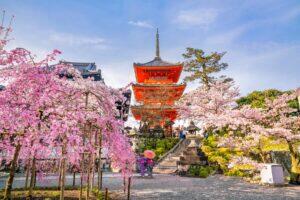Fodor's Expert Review Nijo Castle
Another of Kyoto's World Heritage sites, this castle whose construction began in 1603 is a grandiose and unequivocal statement of power by Ieyasu, the first Tokugawa shogun. In the early Edo period, the shogun stripped all power from Kyoto's Imperial Court by consolidating a new military and political center at his far-off fortress in Tokyo. Nijo-jo's moat and towering walls are intimidating enough, but once inside, a second moat and defensive wall assert the power of the warlord. What seems a second line of defense has less to do with defending the castle than reinforcing the structure's social statement: access to the inner sanctum depended on a visitor's status within the shogunate's hierarchy. Once inside, a guest was as much a hostage as a guest, a point surely driven home by the castle's ingenious nightingale floors, which "chirp" as people walk across them, revealing their movements. If you look under the balcony while strolling the garden, you can observe how the mechanism behind... READ MORE
Another of Kyoto's World Heritage sites, this castle whose construction began in 1603 is a grandiose and unequivocal statement of power by Ieyasu, the first Tokugawa shogun. In the early Edo period, the shogun stripped all power from Kyoto's Imperial Court by consolidating a new military and political center at his far-off fortress in Tokyo. Nijo-jo's moat and towering walls are intimidating enough, but once inside, a second moat and defensive wall assert the power of the warlord. What seems a second line of defense has less to do with defending the castle than reinforcing the structure's social statement: access to the inner sanctum depended on a visitor's status within the shogunate's hierarchy. Once inside, a guest was as much a hostage as a guest, a point surely driven home by the castle's ingenious nightingale floors, which "chirp" as people walk across them, revealing their movements. If you look under the balcony while strolling the garden, you can observe how the mechanism behind this architectural feature works.
The Tokugawa shoguns were rarely in Kyoto. Ieyasu stayed in the castle three times, and the second shogun stayed twice, including the time in 1626 when Emperor Gomizuno-o was granted an audience. After that, for the next 224 years, no Tokugawa shogun visited Kyoto, and the castle fell into disrepair. Only when the Tokugawa shogunate was under pressure from a failing economy did the 14th shogun, Tokugawa Iemochi (1846–66), come to Kyoto to confer with the emperor. The 15th and last Tokugawa shogun, Yoshinobu, famously returned power to the emperor in 1867, the central event of the Meiji Restoration. Since 1939, the castle has belonged to the city of Kyoto, and considerable restoration has taken place.
You can explore Nijo-jo at your own pace, and handy audio guides provide explanations of what you are seeing. Entry is through the impressive Kara-mon gate, whose sharp angles were intended to slow an attack. The path from the Kara-mon leads to the Ni-no-maru Palace, whose five buildings are divided into various smaller chambers. The costumed mannequins inside the central hall are displayed as their real-life counterparts might have reacted at the moment of the Tokugawa shogunate's demise. Following this, governmental power returned to the reigning emperor. The impressive garden was created by landscape designer Enshu Kobori shortly before Emperor Gomizuno-o's visit in 1626. Crane- and tortoise-shape islands symbolize strength and longevity.
READ LESS







